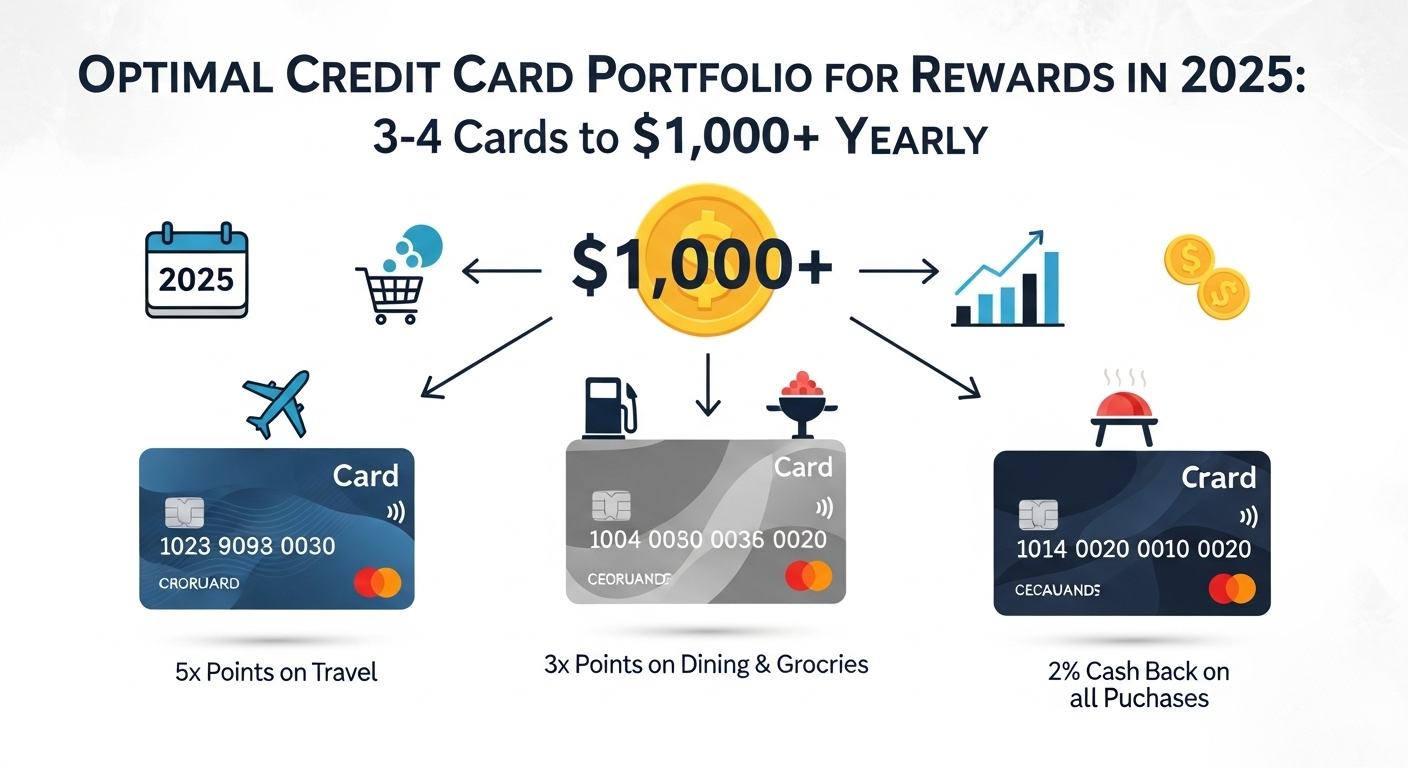Crafting the perfect credit card portfolio is like assembling a winning team—each card plays a specific role to maximize your rewards. In 2025, a strategic 3-4 card setup can deliver $1,000+ annually in cash back, points, or travel perks for those spending $2,000 or more monthly. The Points Guy, and NerdWallet to create this guide. We’ve designed it to help everyone—from rewards enthusiasts chasing 5x travel points to beginners building credit with 2% cash back—build a portfolio that works.
Why a Credit Card Portfolio Matters in 2025
Using a single card limits your rewards to 1-2% on most purchases, but a 3-4 card portfolio can boost returns to 4-6% on $2,500 monthly spending, saving $600-$1,200 yearly. A 2025 Bankrate study found optimized portfolios yield 2.5x more rewards than standalone cards. Here’s why they’re game-changers:
- Category Coverage: Pair cards for 3-5% rewards on dining, groceries, gas, and travel, covering 80% of typical spending.
- Point Pooling: Ecosystems like Chase Ultimate Rewards or Amex Membership Rewards increase point value to 1.5-2 cents each through transfer partners.
- Fee Offsets: Bonuses (50,000-100,000 points) and credits ($200-300 travel) often outweigh annual fees.
- Credit Building: On-time payments across cards can raise FICO scores by 30-50 points in a year.
Risks: Mismanaging multiple cards can lead to $100+ in interest on a $1,000 balance at 25% APR or missed bonuses due to complex rules. In 2025, AI underwriting from issuers like Chase makes approvals easier, even for fair-credit users, opening portfolios to more people.
Building Your Portfolio: The 3-4 Card Blueprint
A strong portfolio balances rewards, fees, and simplicity. Cap at 3-4 cards to avoid complexity and restrictions like Chase’s 5/24 rule (limits approvals after 5 cards in 24 months). Follow this blueprint:
- Analyze Spending: Break down your $1,500-3,000 monthly budget (e.g., 30% groceries, 20% dining, 15% travel).
- Pick an Ecosystem: Choose Chase, Amex, or Capital One for point pooling; mix issuers for cash back.
- Cover Key Categories: Aim for 3-5% on top spends; use a 1.5-2% flat-rate card for everything else.
- Minimize Fees: Prioritize no-fee cards or those with high-value credits (e.g., $300 travel vs. $95 fee).
- Track & Redeem: Use apps like AwardWallet to manage points; aim for 1.5-2 cents/point via transfers.
Eligibility: Most portfolios need a 670+ FICO score, but beginner setups work for fair or no credit. Monitor progress with free tools like CreditWise or Experian Boost.
Top Credit Card Ecosystems for 2025
These ecosystems combine 2-4 cards for maximum rewards, based on 2025 data from The Points Guy and NerdWallet. Each suits different spending habits and goals.
1. Chase Trifecta: Best for Travel Enthusiasts
Perfect for $2,000+/month spenders chasing flights and hotels (1.5-2 cents/point via partners like United).
| Card | Rewards | Annual Fee | Key Perks | Pros | Cons |
|---|---|---|---|---|---|
| Chase Sapphire Preferred® | 5x travel (Chase portal), 3x dining, 2x other travel | $95 | 60,000 points after $4,000 in 3 mo.; $50 hotel credit | 25% point boost in portal; transfer partners | 5/24 rule |
| Chase Freedom Unlimited® | 5x travel (Chase), 3x dining/drugstores, 1.5x other | $0 | $200 after $500 in 3 mo.; 0% APR 15 mo. | No-fee; pairs with Sapphire | High APR post-intro |
| Chase Freedom Flex® | 5% rotating ($1,500/qtr.), 5x travel, 3x dining | $0 | $200 after $500 in 3 mo. | High category rewards | Activation required |
ROI Example: Spend $2,000/month (40% dining/travel, 60% other) for 48,000 points + $200 cash back yearly, worth $720-$960 via transfers.
2. Amex Trifecta: Best for Premium Perks
Suits high spenders ($3,000+/month) seeking luxury travel perks like lounge access.
| Card | Rewards | Annual Fee | Key Perks | Pros | Cons |
|---|---|---|---|---|---|
| American Express® Gold Card | 4x dining/groceries ($25,000/yr.), 3x flights | $250 | 60,000 points after $4,000 in 6 mo.; $120 dining credit | High dining rewards; Uber perks | High fee |
| The Platinum Card® from American Express | 5x flights/hotels ($500,000/yr.), 1x other | $695 | 80,000 points after $8,000 in 6 mo.; lounge access | $200 travel credits; elite status | High spend for bonus |
| Amex EveryDay® Preferred | 3x groceries ($6,000/yr.), 2x gas, 1x other | $95 | 15,000 points after $2,000 in 6 mo.; 50% point bonus (30+ uses/mo.) | Grocery/gas focus | Complex bonus |
ROI Example: $3,000/month (50% dining/groceries, 20% travel) yields 90,000 points ($1,350-$1,800 via partners) + $300 credits, offsetting fees.
3. Capital One Duo: Best for Simplicity
Great for $1,500-2,500/month spenders wanting no-fee cash back or flexible travel rewards.
| Card | Rewards | Annual Fee | Key Perks | Pros | Cons |
|---|---|---|---|---|---|
| Capital One Venture Rewards | 2x miles everywhere; 5x travel (Capital One) | $95 | 75,000 miles after $4,000 in 3 mo.; $100 TSA PreCheck | Flexible redemptions; transfer partners | Limited categories |
| Capital One Quicksilver Cash Rewards | 1.5% cash back | $0 | $200 after $500 in 3 mo.; no foreign fee | Simple; pairs with Venture | Lower rewards |
ROI Example: $2,000/month (30% travel, 70% other) earns 36,000 miles + $300 cash back, worth $660-$900.
4. Beginner Duo: Best for Fair/No Credit
For new users (18-24, 600-670 FICO or no score) building credit with rewards.
| Card | Rewards | Annual Fee | Key Perks | Pros | Cons |
|---|---|---|---|---|---|
| Petal® 2 Visa® | 1-1.5% cash back (increases with payments) | $0 | No credit check; up to $10,000 limit | AI approvals; no fees | No bonus |
| Discover it® Secured | 2% gas/restaurants ($1,000/qtr.), 1% other | $0 | Refundable $200+ deposit; Cashback Match | Upgrades in 7 mo. | Deposit required |
ROI Example: $1,000/month (40% gas/dining) yields $200-$300 cash back after Discover’s match, plus a 650+ FICO in 6 months.
Redemption Strategies for Maximum Value
- Points/Miles: Transfer to partners (e.g., Chase to United, Amex to Delta) for 1.5-2 cents/point vs. 1 cent cash.
- Cash Back: Redeem as statement credits or checks for simplicity; avoid gift cards for lower value.
- Travel Portals: Use Chase or Amex portals for 25-50% point boosts (e.g., Sapphire Preferred’s 1.25x).
- Combine Cards: Pool points within ecosystems (e.g., Freedom Flex to Sapphire) for high-value redemptions.
Tool Tip: Use AwardWallet to track points and set category alerts.
Portfolio Maintenance: Stay Efficient
- Annual Review: Drop cards with low ROI (<1% after fees).
- Monitor Credit: Keep utilization <30%; check FICO via CreditWise.
- Avoid Churn: Stay under Chase’s 5/24 rule; limit applications to 2/year.
- Negotiate Fees: Call issuers annually—60% waive or reduce fees for loyal users.
2025 Trends in Credit Card Portfolios
- AI Underwriting: Chase and Petal approve 85%+ of fair-credit users using bank data.
- Eco-Friendly Perks: Capital One Venture X offers carbon offset rewards for green spenders.
- Hybrid Bonuses: Cards like Discover it® add streaming/travel categories, up 20% from 2024.
- Higher Bonuses: Amex and Chase intros reach 100,000+ points, up 15% from 2024.
Responsible Use: 5 Tips for Portfolio Success
- Pay in Full: Avoid $150+ interest on $1,000 at 25% APR with auto-pay.
- Track Categories: Use Mint to assign cards (e.g., Amex Gold for dining).
- Meet Bonuses: Hit minimum spends ($500-$4,000) within 3-6 months.
- Avoid Cash Advances: 5% fees + 25% APR hurt returns.
- Freeze Unused Cards: Prevent fraud without closing accounts.
Portfolio Flowchart (Text):
- Assess Spend → $1,000-2,000/mo.? Capital One Duo → $2,000+? Chase Trifecta.
- Fair/No Credit? → Beginner Duo (Petal + Discover) → Upgrade in 12 Mo.
- Luxury/Travel? → Amex Trifecta → Redeem via Partners.
Frequently Asked Questions
How many cards should I have? 3-4 for most; 2 for beginners to cover key spends without complexity.
What’s the best ecosystem for beginners? Capital One Duo—simple, no-fee, and flexible.
Can I mix issuers? Yes, but pooling (e.g., Chase) maximizes value; mix for cash back (Citi + Wells Fargo).
How to avoid fees? Choose no-fee cards or offset with credits (e.g., Amex’s $200 travel).
What if I have no credit? Start with Petal® 2 + Discover it® Secured; expect 650+ FICO in 6 months.
Start Your Portfolio in 2025
Ready to maximize rewards? The Chase Trifecta (Sapphire Preferred + Freedom Unlimited + Flex) delivers $700-$1,200 yearly for $2,000+/month spenders. Beginners can pair Petal® 2 Visa® and Discover it® Secured for no-fee rewards and credit building. Have questions? Comment below—our team responds within 24 hours

